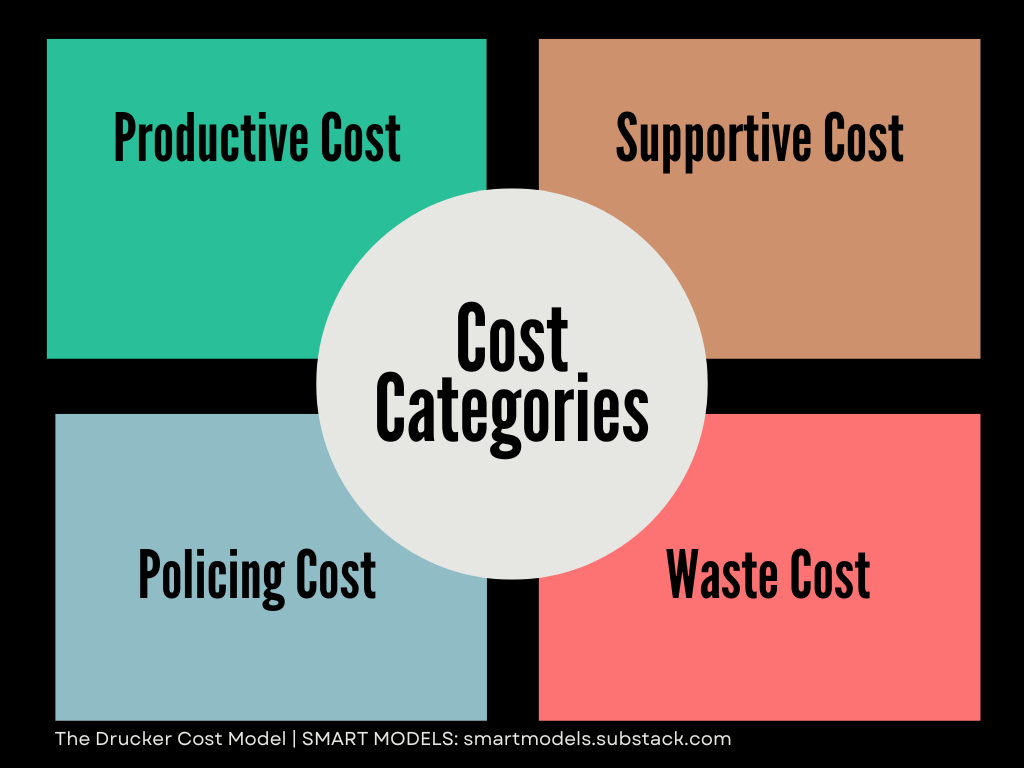The Drucker Way to Cost Analysis
Peter Drucker, a visionary management consultant and the father of modern management, recognized the critical importance of analyzing and controlling costs in a comprehensive manner.
Rather than simply seeking to cut costs sporadically, Drucker advocated for a holistic approach that views the entire business as an integrated system.
This approach is crucial to avoid the pitfall of sub-optimization, where cost reductions in one area inadvertently lead to cost increases in another.
Let's take an in-depth look at Peter Drucker's cost management model:
1) Productive Costs: Maximizing Value Delivery
Productive costs encompass all expenses related to delivering value to customers. These costs include manufacturing, promotional activities, knowledge work, and sales efforts.
Drucker's model prompts organizations to ask key questions:
Efficiency and Effectiveness: What is the most effective way to produce desired results with the least effort and expense?
Incremental Acquisition: How can we increase productive costs to the point where the acquisition of an additional unit of input becomes highly cost-effective?
Resource Concentration: How can we strategically allocate resources to opportunities that allow us to effectively control productive costs while maximizing value delivery?
By focusing on productive costs, businesses can enhance their core operations and deliver greater value to customers.
2) Support Costs: Streamlining Essential Functions
Support costs are necessary for running the business but may not directly provide value to customers. These costs encompass activities like transportation, order handling, inspection, accounting, and administrative tasks.
Drucker's model encourages organizations to:
Essentiality Assessment: Evaluate whether support costs are essential and, if so, determine the minimum cost and effort required.
Process Redesign: Explore opportunities to redesign and reorganize activities to minimize support costs while maintaining essential functions.
Effectively managing support costs ensures that essential business functions are maintained efficiently and cost-effectively.
3) Policing Costs: Ensuring Compliance and Quality
Policing costs are associated with preventing issues and ensuring compliance, particularly in quality assurance activities to monitor and control against undesirable outcomes.
Drucker's model prompts organizations to ask:
Cost-Benefit Analysis: Assess whether the removal of policing costs would result in greater losses compared to the cost of policing.
Efficiency Improvement: Explore ways to minimize policing costs through the use of statistically valid samples and a focus on critical control points.
Efficiently managing policing costs helps organizations maintain quality standards while avoiding unnecessary expenses.
4) Waste Costs: Eliminating Inefficiencies
Waste costs encompass any efforts that do not yield results or value, such as idle time, inefficiencies, and non-productive activities.
Drucker's model suggests the following considerations:
Identifying Wasteful Activities: Identify areas where resources are spent on activities that do not produce results or value.
Hidden Costs of Inaction: Evaluate the hidden costs of not addressing wasteful activities and determine strategies to minimize them.
Redesign and Elimination: Explore opportunities to drop wasteful activities and invest efforts in eliminating waste, even if it involves redesigning the business or changing operating practices.
By addressing waste costs, organizations can enhance efficiency, reduce unnecessary expenses, and optimize resource utilization.
Drucker Model's Holistic Approach
Drucker's cost management model offers a holistic approach that goes beyond traditional cost analysis methods. It emphasizes:
Maximizing Value: Focusing on value-adding activities.
Optimizing Efficiency: Seeking continuous improvements for efficiency.
Resource Allocation: Strategically allocating resources for effective cost control.
By adopting Drucker's model, businesses can gain a deeper understanding of their cost structure, make informed decisions, and achieve sustainable cost management while maximizing overall organizational effectiveness.
Here’re 3 ways I can help you whenever you’re ready:
Join 5800+ business leaders getting ONE actionable model to solve problems, make informed decisions, and lead with influence - every Friday.
Book 30-minutes FREE consulting call on winning Lean Six Sigma execution.
Speaking Arabic? Join 150+ happy clients enrolled in my Lean Six Sigma training program and private coaching to become ASQ Certified and Real Practitioners.




